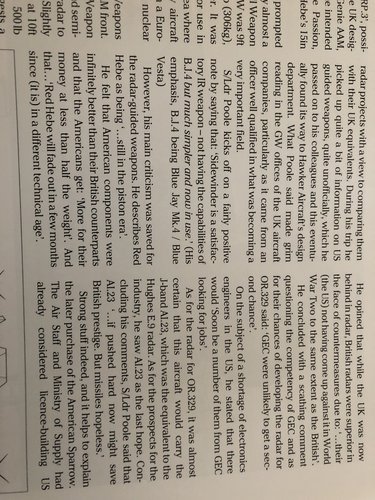I’m pretty sure that’s not what I was contending (for example I wasn’t saying that the UK couldn’t build the TSR2 or F155T from a technical perspective, just that they were too demanding to do so and be affordable at the same time) and it’s certainly an interesting perspective to essentially blame every such failure on “project management”.
However I am ultimately happy to leave it to other contributors to make their own minds up.
You very clearly stated that "
the TSR2 and F.155T designs were “too much” for the UK to pull off both technically and financially" which can only be interpreted as you "
saying that the UK couldn’t build the TSR2 or F155T from a technical perspective".
It also very clear from my posts through this thread, specifically post 48, that I am not blaming every such "failure" on program management. You are deliberately misrepresenting my views.
Your comments suggest your English comprehension could do with some work while I need to work on being a bit clearer - I clarified, and your still appear insistent on having an argument...
But to cut through some of the clutter, and some apparent animosity coming from somewhere (?), I would also clarify that I think it is disingenuous and/or self-deceptive to blame "project management" on a number of the misconceived/ failed projects named above.
A number of them were set up for failure almost from conception by excessive ambition and not fully taking into account the real technical and/or fiscal realities UK projections were born into.
Evidence suggests that Red Dean (& Red Hebe) were heading to be horrible technical failures, hobbled by inferior technology being pushed past what it could achieve. I would suggest you read the fascinating content in the relevant UK secret project books for more detail on this.
Without the 1957 Defence Paper the F155T would very likely proved to be unaffordable (and badly matched to future requirements, but in that they were very much not alone). The RAF was trying for too much but industry had its own issues.
While superficially comparisons with projects like the F-108 may appear to be like-for-like there is one very important difference. The US could afford dozens of such projects, complementary aircraft etc. etc. while the UK could not. The F-108 was a significantly more advanced weapons system and co-existed with a number of other tactical fighters etc. in a way the F155T could never have done so.
TSR2 is the classic case of the best being the enemy of the good; again even with better project management the chances of an affordable outcome were slim and the TSR2 weapon systems would have very likely become its own mini-debacle. If just about technically feasible the TSR2 in the form in which it emerged was also likely to never be fiscally affordable. An given that it was replaced by the Buccaneer it does suggest that requirements were pushed past what was really necessary at that time.
And even relative UK successes in the 1950s-70s had a tendency to be only about as good or a times marginally better than direct US equivalents but many times more expensive.
But to be fair I think the UK learned a lot from these programs (which were also very much projects of the their time and that time's dominant mindsets); the fact that a lot of the future projects tended to by multi-national helped but that wasn't the only factor.
AEW Nimrod is an example of lessons being forgotten and then being learned again, only to be forgotten again.
Hope the Project Tempest people have brushed up on their aviation history.
And in comparison with the French and the Swedish I struggling to come up with a similar pattern of pushing too far and then doubling down and keep digging themselves a deeper hole.
The French themselves had a sea of ultimately unsuccessful prototypes but a lot of that was due to being out-competed by Dassault and/or Dassault convincing the French authorities to instead go with something that was easier for them to sell abroad.
Maybe Rafale could almost be seen as something similar but it hardly compares in terms of negative outcomes.
I'll hold up my hand and say I don't know as much about Saab and Sweden's projects but I'm not aware of a direct equivalent to the examples I've mentioned above.
Hence I'm not at all saying the UK was in any way technically inferior to France or Sweden (Sweden bought Bloodhounds & Skyflashes after all); the UK had and has a superb aviation engine industry and many fine successful programs.
I'm simply saying when you look at who spent what for what the French and the Swedes often got more bang-for-the-buck than the UK.
And often that can be traced back to more realistic and less ambitious requirements, and the mindset of those setting these requirements is a significant factor in this.
I'm open to constructive feedback if any contributors other than JFC Fuller or the usual suspects have some.






